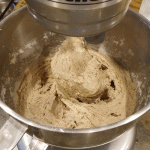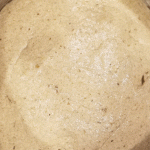| Rye %: | 89% |
| Stages: | Sponge, Soaker, Final dough |
| Leaven: | Rye sour culture, Instant yeast |
| Start to Finish: | 18-20 hours |
| Hands-on Time: | 30-40 minutes |
| Yield: | One 2½ lb/1.2 kg loaf |
I found this flavorful, crusty rye bread in one of the first German baking books I acquired, Rustikale Brote aus deutschen Landen (Rustic Breads from the German Countryside) by Gerhard Kellner, a well-known German bread blogger who goes by the nickname “Ketex.” It intrigued me for a couple of reasons.First, I had never come across toasted and ground sunflower seeds in a soaker, and second, it called for German types 1150 rye flour and 1050 wheat flour, both of which I had on hand, compliments of a German baking friend. Using the German flour also gave me a chance to do a taste comparison against the American rye flour I generally use. And unlike the 12-hour sponge of the Austrian Bauernkrustenbrot I posted almost a year ago, this version uses an acidification sponge that ferments for 16-18 hours, producing a more pronounced and insistent sour.
 I ended up baking this bread twice. The first time, I used the German flour and followed Ketex’s recipe to the gram – only to end up with a very loose and sticky dough that clung fast to the proofing basket when I attempted to flip it onto my peel, then spread like a pancake during baking. Flattened and bumpy-crusted as it was, Ketex’s version had a tender, open crumb and a flavor profile that emphasized sweetness of the German rye – European ryes tend to be sweeter and milder than the American variety – and the nuttiness of the sunflower seeds, followed by a mild sour finish.
I ended up baking this bread twice. The first time, I used the German flour and followed Ketex’s recipe to the gram – only to end up with a very loose and sticky dough that clung fast to the proofing basket when I attempted to flip it onto my peel, then spread like a pancake during baking. Flattened and bumpy-crusted as it was, Ketex’s version had a tender, open crumb and a flavor profile that emphasized sweetness of the German rye – European ryes tend to be sweeter and milder than the American variety – and the nuttiness of the sunflower seeds, followed by a mild sour finish.
Version two was very different. For one thing, I used American rye flours that I blended to reflect the ash/protein composition of the German Type 1150 flour. For another, I reduced the water in the final dough from the original 200 grams to 175 grams, and in fact could probably have reduced it further to 160 grams, since the loaf spread more than I wanted during baking. Nonetheless, the flavor was outstanding. Like its German cousin, the American loaf featured a tender and open crumb, but had a more intense flavor profile in which the nuttiness of the sunflower seeds and sweet- bitter rye notes came to the fore. The sour was also much more pronounced.
Side by side, the American rye flour won the day – as it has against Russian and other German rye flours I’ve had the opportunity to bake with, but, of course, that’s just a personal preference. I will say, though, that this bread pairs beautifully with strong flavors. I like it with thinly sliced cheese for breakfast, strong sausages like andouille, soppressata and cervelat for lunch, and by itself, lightly filmed with butter any time at all.
Sponge (Day 1, Afternoon):
| Ingredient | Grams | Ounces | Baker’s Percentage |
| Medium rye flour | 290 | 10.25 | 100% |
| Warm (105°F/41°C) water | 290 | 10.25 | 100% |
| Rye sour culture | 30 | 1.05 | 10% |
 In the mixer bowl, combine the sponge ingredients.
In the mixer bowl, combine the sponge ingredients.
 Cover and ferment at room temperature (70°F/21°C) 16-18 hours. The sponge will have tripled in volume and show broken bubbles on the surface.
Cover and ferment at room temperature (70°F/21°C) 16-18 hours. The sponge will have tripled in volume and show broken bubbles on the surface.
Soaker (Day 1, Evening):
| Ingredient | Grams | Ounces | Baker’s Percentage |
| Raw unsalted Sunflower seed | 100 | 3.55 | 100% |
| Warm (105°F/41°C) water | 100 | 3.55 | 100% |
 In a skillet, toast the sunflower seeds over low-medium heat, stirring constantly, until they become fragrant and turn a golden brown. Be careful not to let them char.
In a skillet, toast the sunflower seeds over low-medium heat, stirring constantly, until they become fragrant and turn a golden brown. Be careful not to let them char.
 Let cool, then use a blender or food processor to grind them fine. Combine them with the water, cover and let stand for at least 2 hours.
Let cool, then use a blender or food processor to grind them fine. Combine them with the water, cover and let stand for at least 2 hours.
 I soaked mine overnight and the seeds absorbed all the water.
I soaked mine overnight and the seeds absorbed all the water.
Final Dough (Day 2, Morning):
| Ingredient |
Grams |
Ounces |
| Sponge |
610 |
21.50 |
| Soaker |
200 |
7.10 |
| Medium rye flour |
175 |
6.15 |
| White rye flour |
125 |
4.40 |
| First clear or high-gluten flour |
70 |
2.45 |
| Warm (105°F/41°C) water |
175 |
6.15 |
| Salt |
13 |
0.45 |
| Instant yeast |
4 |
0.15 |
 In the mixer bowl, combine the final dough ingredients and use the dough hook at low (KA2) speed to mix until the dough comes together into a firm, sticky mass, 7-8 minutes.
In the mixer bowl, combine the final dough ingredients and use the dough hook at low (KA2) speed to mix until the dough comes together into a firm, sticky mass, 7-8 minutes.
 Cover the bowl with plastic wrap and bulk ferment at room temperature for 30 minutes; the dough will have visibly expanded and show cracks or broken bubbles on the surface.
Cover the bowl with plastic wrap and bulk ferment at room temperature for 30 minutes; the dough will have visibly expanded and show cracks or broken bubbles on the surface.
 Turn the dough, which will be soft and sticky, onto a well-floured work surface and use floured hands and a bench knife to shape it into a boule.
Turn the dough, which will be soft and sticky, onto a well-floured work surface and use floured hands and a bench knife to shape it into a boule.
 Place the dough seam side up into a well-floured proofing basket and cover with plastic wrap.
Place the dough seam side up into a well-floured proofing basket and cover with plastic wrap.
 Proof at 85°F/30°C until the dough has reached the rim of the basket. If you don’t have a proofer, place the loaf in an oven that’s been preheated for 1 or 2 minutes and then turned off. Alternatively, proof it in the ovenwith the light turned on. If neither of these methods works, proof at room temperature for about 90 minutes.
Proof at 85°F/30°C until the dough has reached the rim of the basket. If you don’t have a proofer, place the loaf in an oven that’s been preheated for 1 or 2 minutes and then turned off. Alternatively, proof it in the ovenwith the light turned on. If neither of these methods works, proof at room temperature for about 90 minutes.
 Preheat the oven to 480°F/250°C with the baking surface in the middle and a steam pan on a lower shelf. Flip the loaf onto a well-floured peel, if using a baking stone, or a parchment-lined sheet pan and score in a diamond pattern to a depth of at least ¼”/0.6 cm.
Preheat the oven to 480°F/250°C with the baking surface in the middle and a steam pan on a lower shelf. Flip the loaf onto a well-floured peel, if using a baking stone, or a parchment-lined sheet pan and score in a diamond pattern to a depth of at least ¼”/0.6 cm.
Bake with steam for 15 minutes, then remove the steam pan, reduce the temperature to 355°F/180°C and continue baking until the loaves thump when tapped with a finger and the internal temperature is at least 198°F/92°C, about 35-40 minutes. Transfer to a rack and cool thoroughly before slicing.
Baker’s Percentages:
| Ingredient |
g |
% |
| TOTAL FLOUR |
660 |
100.00% |
| Medium rye flour |
465 |
70.45% |
| White rye flour |
125 |
18.94% |
| First clear flour |
70 |
10.61% |
| Water |
465 |
70.45% |
| Salt |
13 |
1.97% |
| Rye sour culture |
30 |
4.55% |
| Instant yeast |
4 |
0.61% |
| Sunflower seeds |
100 |
15.15% |
| Soaker water |
100 |
15.15% |
| TOTAL FORMULA |
1,372 |
207.88% |
| Prefermented flour |
290 |
43.94% |



Gary
May 13, 2017Looks great.
Note:Clerical error….”sponge” is called “scald” in the “final dough”.
Geoffrey Smith
May 13, 2017Hi you mention a 200 g scald in the ingredients list, but it is not mentioned in the method,,,
Stanley Ginsberg
May 14, 2017My mistake: I erroneously described the soaker as a scald in the final dough ingredients. That error has been corrected. Thanks for the heads-up!
Karin Anderson
June 2, 2017Very interesting! This just proves again that one should always go by the required consistency of the dough, not just slavishly following the recipe amounts.
In 2011 I posted a comparison of a German rye bread made with German rye type 1150 and NYBaker’s medium rye in The Fresh Loaf, concluding that American medium rye “won”: http://www.thefreshloaf.com/node/25482/who-winner-medium-rye-comparison
Marisa
June 17, 2017A new favourite around here now – baking it today for the third time today.
Marisa
June 17, 2017Ignore the second “today” ;^)
(Typing too fast, as a timer had gone off).
Tomasz
June 17, 2018Great bread, cuts very nicely, good flavor of sunflowers. I baked it in the pan, though.
Brad
August 21, 2018This looks like a great bake. I’m interested in trying it, but I have a question about your brotform. Since you gauge the proof based on reaching the rim of the brotform, the size seems important. Are you using a 9” diameter basket? Thanks.
Stanley Ginsberg
August 26, 2018Yes I am.
Pingback: Ketex’s Crusty Boule/Bauernkruste Variation – Frodobakes